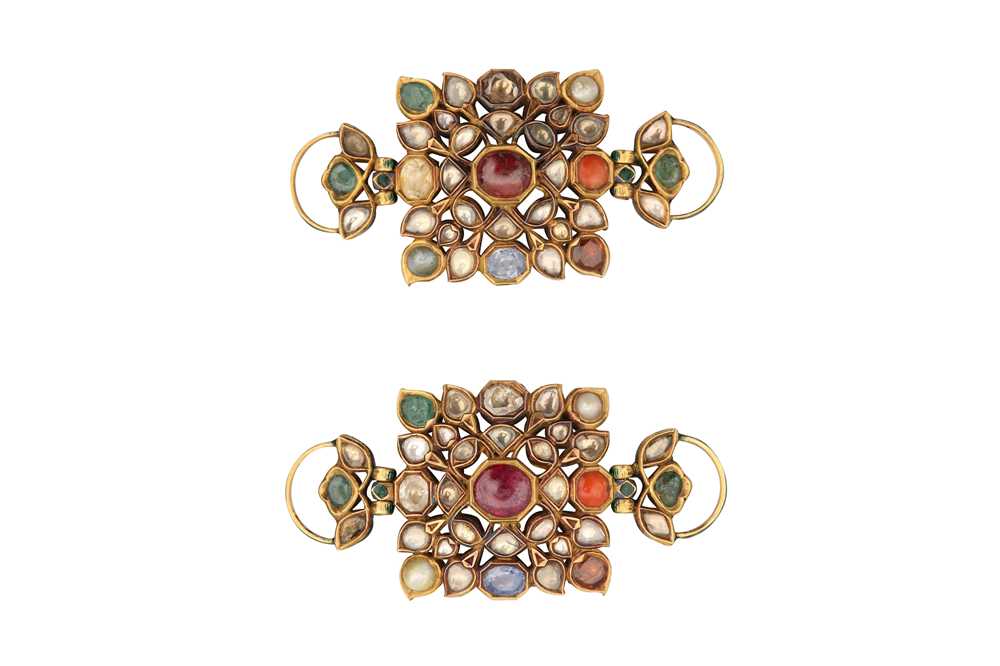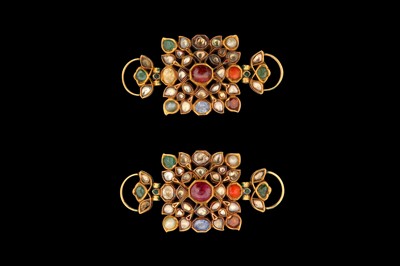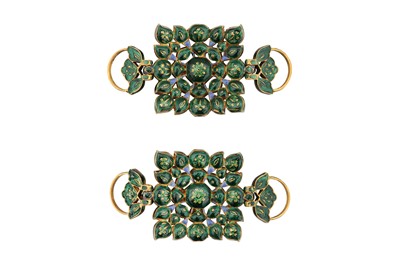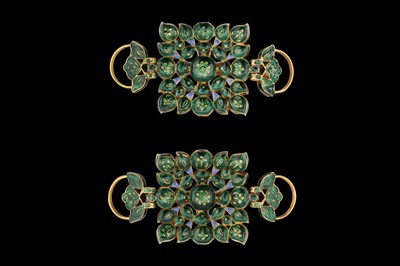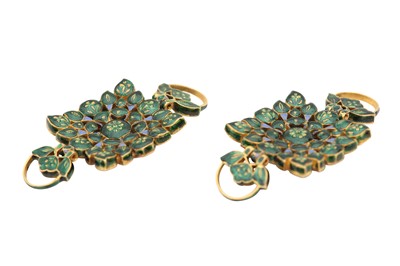28th Oct, 2022 14:00
Islamic & Indian Art
λ A PAIR OF ENAMELLED GOLD NINE-GEM (NAVRATNA) ARMLETS (BAZUBAND)
Jaipur, Rajasthan, North-Western India, first half 19th century
λ A PAIR OF ENAMELLED GOLD NINE-GEM (NAVRATNA) ARMLETS (BAZUBAND)
PROPERTY FROM A PRIVATE UK COLLECTION
Jaipur, Rajasthan, North-Western India, first half 19th century
Comprising two gem-encrusted kundan-set openwork square plaques for bazubands (upper arm bracelets), designed as a floral burst with a rosette in the centre surrounded by buds and foliage, on each side a hinged hoop with foliate elements set with emerald and white sapphire beads, the central panel on each bazuband gently curved and showcasing in the front an elegant display of navratna gems (ruby, pearl, coral, garnet, blue sapphire, cat's eye, yellow topaz, emerald, and diamond) in gold kundan setting, mirroring the Navgraha Yantra, a diagram representing the nine planets of the Hindu astrological system, the remaining foliage and petals fillers set with a mix of white sapphires, zircons and polki diamonds, the back enhanced with a champlevé green-enamelled ground with light blue highlights and incised gold flowers, each 6.8cm x 3.3cm, each 31gr.
Oppi Untracht, one of the leading scholars of traditional Indian jewellery, once described the navratna (or nava-ratna) gemstone concept as a "celestial palladium", embodying the symbolic analogy between the microcosm (humankind) and the macrocosm (universe). The nine gemstones always featured in a navratna piece of jewellery are ruby, pearl, coral, garnet, blue sapphire, cat's eye, yellow topaz, emerald and diamond. This fascinating concept is truly autochthonous to India and to fully appreciate its multiple levels of complex meaning, one has to delve into a discussion of the basic notions of Hindu astrology, which in time was also adopted by Jains, Buddhists, and occasionally, by Muslims (Oppi Untracht, Traditional Jewelry of India, 2008, pp. 304 - 309). The Mughal emperors, for instance, were known for wearing navratna jewellery, especially in the form of upper arm bracelets and pendants, and this trend contributed to the increased desirability of these gemological compositions and their long-lasting influence in North Indian jewellery well into the 18th and 19th centuries (Rita Devi Sharma and M. Varadarajan, Les Bijoux Artisanaux Indiens en Email, 2004, p. 42).
The oldest reference to navratna stones, classified into great and lesser gems, appears in the Agastimata treatise, an ancient Indian manual on gemstones written before the 10th century AD. However, way before this time, gemstones, a product of nature imbued with special intrinsic powers, were used in India for preventive, antidotal, and therapeutic purposes. It is only natural to expect that certain gemstones became thus associated with specific deities and qualities. Among the various gods of the Hindu pantheon, there are nine celestial deities, the Navgraha (or 'nine seizers'), corresponding to seven planets and two personifications of the moon cycle forming the universe, according to Hindu cosmological texts. The Navgraha are the Sun (Surya), Moon (Chandra), Mercury (Budha), Venus (Shukra), Saturn (Shani), Mars (Mangala), Jupiter (Brhaspati), the Ascending Moon's node (Rahu), and the Descending node (Ketu). These celestial entities, all conceived as male deities with their peculiar attributes and lakshanas (unique qualities), are believed to seize upon humans and influence their destiny (Oppi Untracht, Traditional Jewelry of India, 2008, p. 305). For example, the moon, Jupiter and Venus are all believed to be beneficent and lucky bodies, whilst the sun, Mars and Saturn are harder to control and as such, can become maleficent or unlucky bodies, if channeled incorrectly. Every celestial deity possesses exceptional magic powers and can act as a medium for the transmission of stored energy from the planets to the wearer of their stones.
But for the navratna gems to fully express their potential, they must be arranged in a very specific order, which bears into consideration their relation to the celestial Navgrahas, the regents of the space and sky. This order is described in the Navaratnashastra and effectively creates a miniature diagram (or metaphor) of the universe itself (Usha R. Bala Krishnan and Meera Sushil Kumar, Dance of the Peacock: Jewellery Traditions of India, 1999, pp. 251 - 252). The display of the nine gems ought to follow precise cosmic directional patterns, mindful of the celestial deities' guardianship of specific directions. These cosmological rules imposed on the genius of medieval Indian jewellers led to the creation of carefully-crafted and fully thought-through amulets traditionally of square shape (later on, also circular), with three stones on each square side and one in the centre. Fixed by cardinal points, the square is believed to be a final, unequivocal form indicating the Absolute, a mandala of the full Universe. Since the Hindus worship the Sun and determine spatial directions in its reference, it should not surprise that in the centre of this mandala there is a ruby (Surya's gem).
Navratna bazubands, especially late 18th and early 19th-century examples, have proved to be very desirable, making their successful appearance more than once in the London auction market. For further reference, please see Christie's London, 6 October 1999, lot 27; and 11 April 2014, lot 67; and more recently, Bonhams London, 23 October 2018, lot 168. For another gem-encrusted kundan-set openwork square bazuband plaque almost identical to ours, part of a private collection in Brussels, please see Oppi Untracht, Traditional Jewelry of India, 2008, cat. 711, p. 304. For another similar nine-gem bazuband with light blue enamel at the back like ours, please see Usha R. Bala Krishnan and Meera Sushil Kumar, Dance of the Peacock: Jewellery Traditions of India, 1999, cat. 376, p. 232.
This item may require Export or CITES licences in order to leave the UK or the European Union. It is the buyer's responsibility to ensure that lots have the relevant licences before shipping.
Sold for £5,625
Includes Buyer's Premium
Do you have an item similar to the item above? If so please click the link below to submit a free online valuation request through our website.
